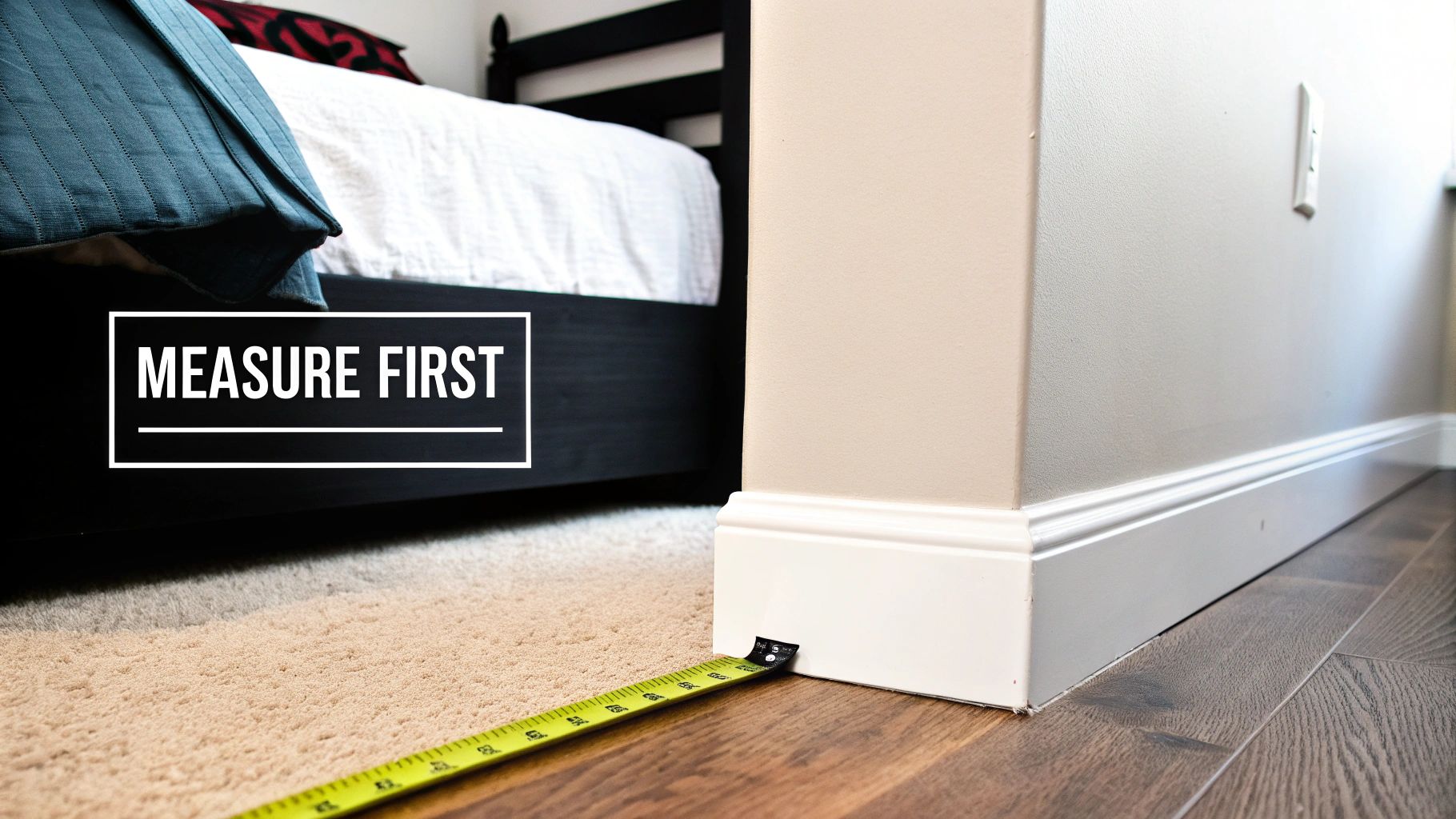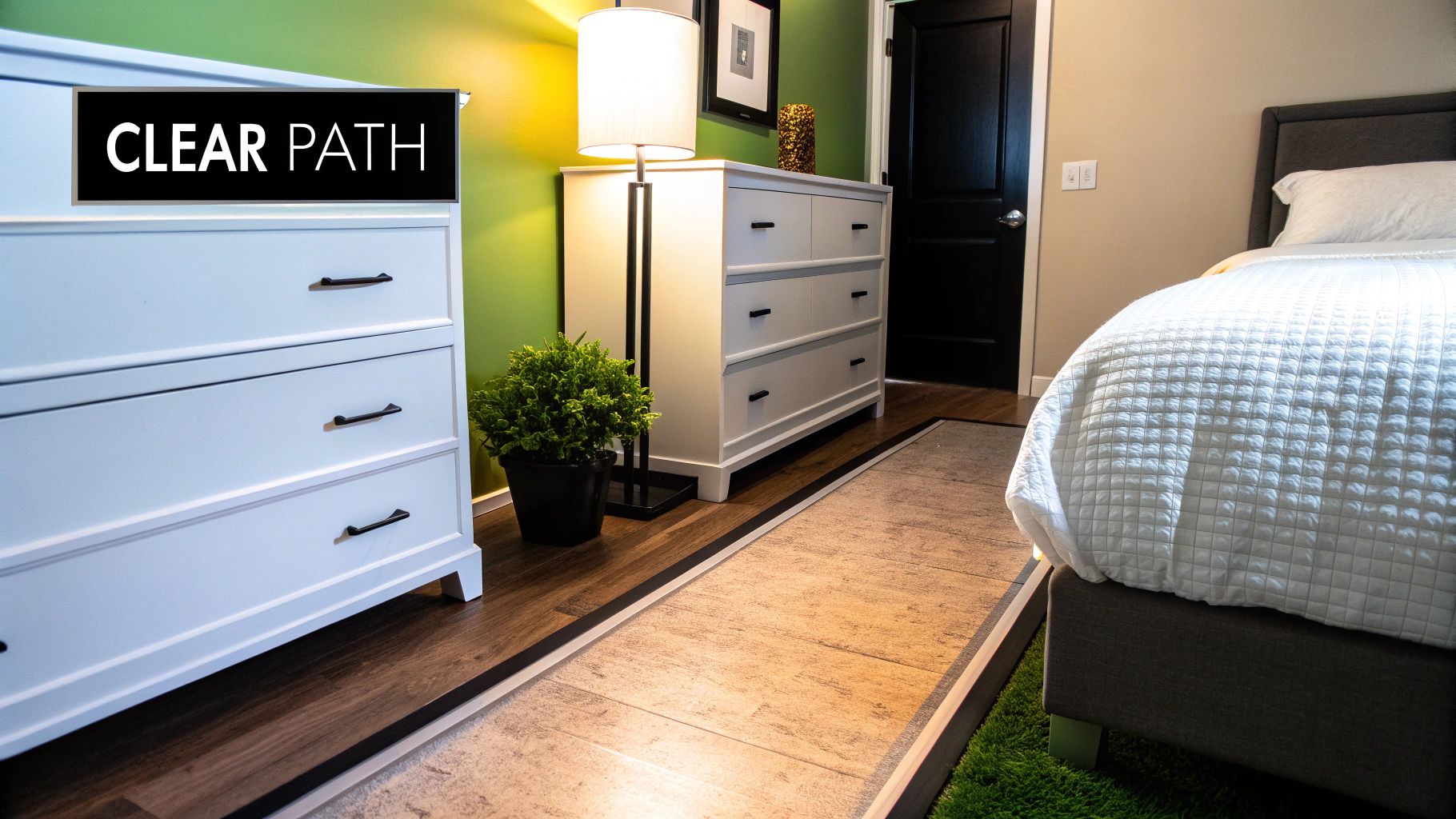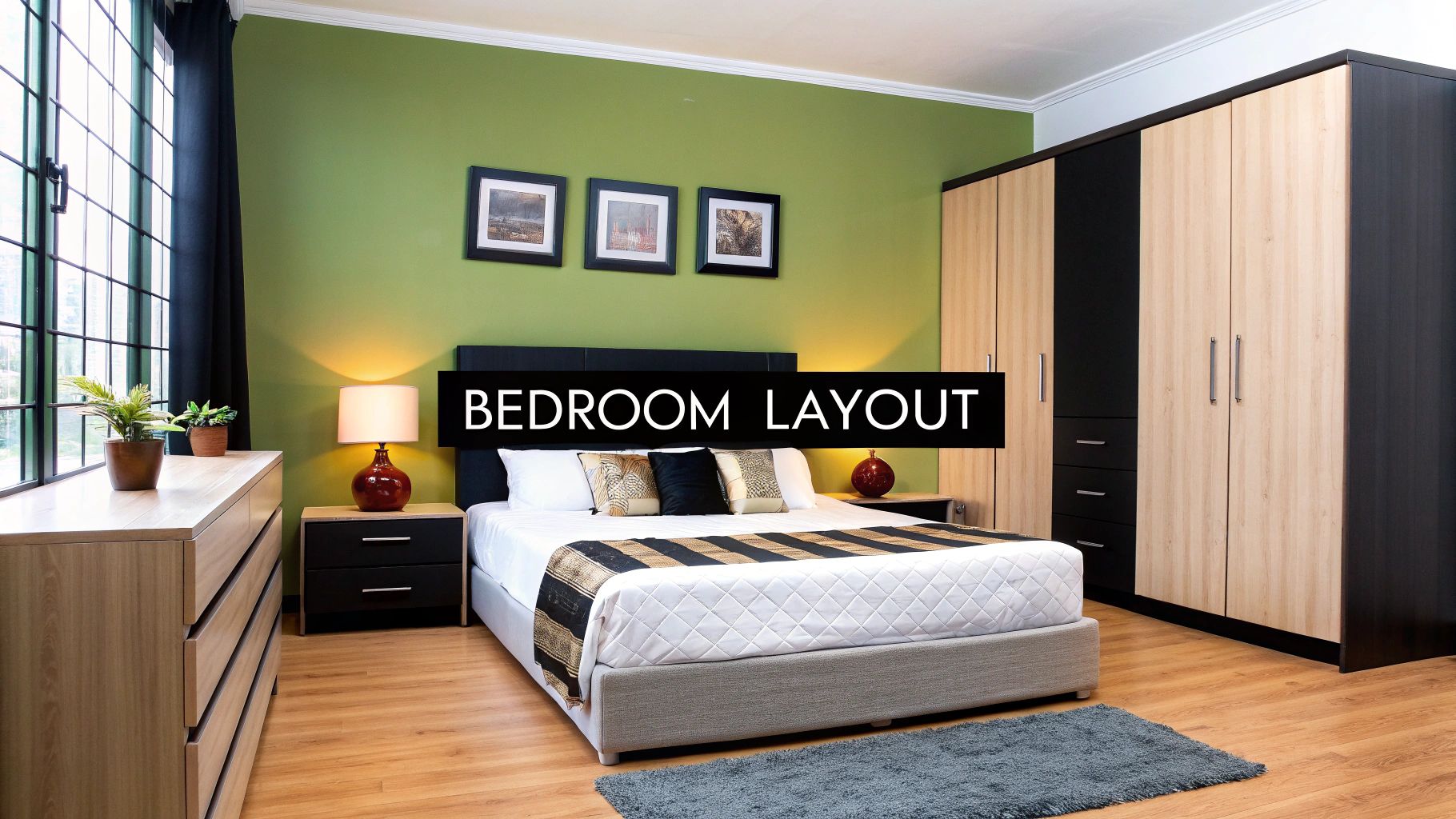Arranging your bedroom furniture should start with a simple plan, not with heavy lifting. The secret is to measure your space, sketch a quick layout, and find a focal point before you move a single thing. A little preparation makes the difference between a room that just works and one that feels balanced, practical, and perfectly yours.
Your Blueprint for a Better Bedroom
Before you start wrestling with wardrobes and bed frames, taking a moment to plan can save you a world of effort. A well thought out bedroom layout is not just about looks; it is about creating a space that feels calm, organised, and easy to live in. Think of it as drawing up a blueprint for your own personal retreat.
This is your chance to decide how your room will function day to day. You get to design a flow that makes sense for your routine, from getting ready in the morning to winding down at night. By sorting out the practical things first, you can make sure the final result is both stylish and genuinely liveable.
Mapping Out Your Space
The first real step is to get to know the canvas you are working with. Grab a tape measure and jot down the room's main dimensions. Crucially, do not forget to note where any permanent features are, as they will dictate where your furniture can and cannot go.
Here are the essentials to measure and record:
- Room Dimensions: The total length and width of the room.
- Doors and Windows: Mark their location and size, and always note which way the doors swing open. This is a classic mistake.
- Architectural Features: Take note of any radiators, built in wardrobes, or awkward alcoves.
- Power Sockets: Knowing where your plug sockets are is vital for placing bedside lamps, chargers, and anything else you need to plug in.
This simple act of measuring is the foundation of any good furniture arrangement, as this visual helps to explain.
Mapping out these fixed elements helps you see the usable space with fresh eyes, preventing common frustrations like blocking a window or creating an awkward walkway.
A great layout does more than just fit everything in; it creates a sense of harmony and ease. The goal is to make your bedroom a true sanctuary, and that journey begins with a simple sketch and a tape measure.
With your measurements in hand, you can start to play with the possibilities. A quick, rough sketch on a piece of paper is all you need at this stage. You are not creating a masterpiece, you are just giving yourself a bird's eye view to experiment with different arrangements without breaking a sweat.
This planning phase is also the perfect time to think about your room's overall feel. For some brilliant inspiration, exploring different modern bedroom colour schemes can help you lock in a mood before you commit to a final layout.
Placing Your Bed: The Heart of the Room
Let's be honest, the bed is the star of the show in any bedroom. It is the single most important piece of furniture, and where you decide to put it will dictate the entire flow and feel of your space. Think of it as the anchor. If you get its position right, everything else naturally falls into place, creating that sense of calm and order we all crave.

From my experience, the best spot is almost always against the main, solid wall you face as you enter. This placement immediately establishes the bed as the focal point, which feels both balanced and incredibly welcoming. There is also a subtle psychological benefit here. Being able to see the doorway from your bed can create a sense of security, helping you relax and unwind more easily at the end of the day.
Finding the Perfect Wall
Of course, not every room has an obvious "main wall." Sometimes awkward layouts or architectural quirks mean you have to get a bit more creative. The end goal is always the same: find a spot that promotes easy movement and feels visually balanced.
Here are a few practical tips I always share with clients:
- Centre It Up: Whenever you can, try to centre the bed on its wall. This creates a natural symmetry and leaves equal space on either side for bedside tables and movement.
- Avoid High Traffic Paths: The last thing you want is to be squeezing past the corner of your bed to get to the wardrobe. Make sure the placement does not obstruct the natural walkways in the room.
- Mind the Windows: As a general rule, it is best to avoid placing a bed directly under a window. It can feel draughty, block precious natural light, and sometimes just feel a bit exposed. If it is your only option, a tall, solid headboard can act as a great visual anchor to ground the space.
A key takeaway from countless room designs: aim for at least 60cm (about two feet) of clear space on both sides of the bed. This is the magic number for feeling comfortable, not cramped, and gives you plenty of room for nightstands.
Creating Balance and Symmetry
With your bed perfectly positioned, the next step is to build a sense of balance around it. Symmetry is one of the simplest yet most effective tools in interior design. It makes a space feel instantly more organised, intentional, and profoundly peaceful.
Achieving this is simpler than it sounds. A classic approach that always works is to place matching bedside tables on either side. This provides function while creating that pleasing visual harmony. Top them off with a pair of matching lamps, and you have nailed the look.
The size of your bed obviously plays a massive role in all of this. Once it is in place, dressing it beautifully is the final, crucial touch. Ensuring you have the right bedding is key to creating that polished, complete feel. If you need a hand, this is a helpful guide to determine the perfect king-size bedsheet size in cm for your centrepiece. A well made bed is what truly solidifies its role as the heart of the room.
Arranging Wardrobes and Smart Storage
Once your bed is settled, it is time to tackle the next big players: your wardrobes and chests of drawers. How you place these larger storage pieces is the secret to a calm, clutter free room that feels open and spacious, not cramped and chaotic. The goal is to create a sense of balance, making even bulky furniture feel like it belongs.
A strategy I always come back to is placing the largest storage item, usually the wardrobe, along the longest solid wall. This is often the most efficient use of space, helping the wardrobe blend in rather than loom over you. It also keeps the main pathways clear, so you are not constantly navigating an obstacle course.
Smart Solutions for UK Homes
Let's be honest, many of us in the UK are working with bedrooms that are on the cosier side. This means we have to be a bit clever. It is no surprise that the demand for compact, multifunctional furniture is on the rise, as highlighted by this research into the UK home furniture market.
This push for smarter furniture has given us some fantastic options for tight spots:
- Sliding Doors: A wardrobe with sliding doors is an absolute game changer. You do not need to account for door swing, which instantly frees up precious floor space.
- Go Vertical: Taller, slimmer units are your best friend in a small room. They draw the eye upward, creating an illusion of height, while still packing in plenty of storage.
- Mirrored Finishes: It’s a classic trick for a reason. Choosing wardrobes with mirrored doors bounces light around, making the entire room feel brighter and significantly larger.
Before you commit to a spot, always, always do the door swing test. Open every wardrobe door and pull out every drawer to its full extension. Make sure they do not hit the bed, knock over a lamp, or block a doorway. It is a simple check that can save you from a major daily headache.
A well placed wardrobe should feel like a natural part of the room's architecture. It should offer maximum storage with minimum intrusion, keeping your sanctuary feeling serene and uncluttered.
Finding the right inspiration can completely change how you see your space. For anyone grappling with a smaller room, our guide on apartment bedroom decorating ideas is filled with practical tips to help you make the most of every square inch.
Balancing Heavy Furniture
With your main storage sorted, think about where to place other items like a chest of drawers to create visual balance. If your tall wardrobe is on one side of the room, placing a lower, wider chest of drawers on the opposite wall can distribute the visual weight perfectly.
This stops one side from feeling heavy and cluttered while the other feels bare. You are aiming for a layout where your eye moves smoothly around the space, with each piece complementing the others to create a cohesive, finished look.
Creating Functional Zones in Your Bedroom
Once your bed and main storage are sorted, the fundamental layout of your bedroom is in place. But a bedroom can be so much more than just a place to sleep and store clothes. The next step is to arrange the other pieces of furniture to carve out dedicated zones for different activities, transforming your room into a space that truly works for your lifestyle.
Thinking in ‘zones’ is a game changer. It turns a single use room into a multi functional retreat by giving every corner a clear purpose. This approach not only keeps the space organised but also makes your daily routines feel smoother and far more enjoyable.

This idea of a bedroom that does more is not just a fleeting trend. The UK furniture retail market is projected to hit £19.5 billion by 2025, a shift largely driven by our growing desire for personalised, versatile living spaces. With remote work becoming the norm for many, it is thought that around 30% of UK households now have some form of workspace furniture in their bedrooms. You can dig deeper into these evolving trends in the UK furniture retailing market report.
Carving Out a Cosy Reading Nook
One of the most rewarding additions you can make to a bedroom is a dedicated reading corner. It is a simple way to create a personal sanctuary, a quiet spot to unwind with a good book, away from the buzz of the main living areas. And you really do not need a huge amount of space to pull it off.
To create your own little escape:
- Find a quiet corner, preferably near a window to take advantage of natural light.
- Add a comfortable chair. An inviting armchair or a classic chaise longue works beautifully. It should be a piece that just begs you to sit down and relax.
- Complete the setup with a small side table for a cup of tea and, crucially, good lighting. A slim floor lamp is a fantastic choice, offering focused light without eating into your floor space.
Designing a Practical Dressing Area
Another brilliant zone to consider is a dedicated dressing area. This simple addition can make getting ready in the morning feel less like a frantic rush and more like a calm, luxurious ritual. It consolidates everything you need into one spot, so you are not dashing from one side of the room to the other.
Start by placing a stylish full length mirror near your wardrobe. If you have the room, a small vanity or a slim console table with a comfortable stool can elevate the space. The key here is good lighting. Make sure the area is well lit, either by a window or well placed artificial lights, so you can see your outfits perfectly. For more inspiration on tying the look together, have a look at our guide to the best bedroom decor ideas.
A strategically placed rug is a fantastic way to visually separate a zone from the rest of the room. A soft, circular rug under your reading chair, for instance, instantly defines that corner as its own cosy space.
Adding the Finishing Touches
Now that your main furniture pieces are perfectly in place, it is time for my favourite part, the final layer. These are the details that elevate a well arranged room into a space that feels personal, inviting, and truly finished. Think of things like lighting, textiles, and accessories as the elements that tie everything together, adding warmth, character, and your unique stamp.
This is where you really breathe life and soul into the room. It is about so much more than just filling empty spaces. It is a chance to thoughtfully choose items that make the space feel cohesive, comfortable, and completely yours. From the rug underfoot to the art on your walls, these are the final elements that make all the difference.
The Power of Layered Lighting
I cannot stress this enough: good lighting is one of the most transformative elements in any room, yet it is so often overlooked. Just relying on a single, harsh ceiling light is a surefire way to make a bedroom feel stark and unwelcoming. The real secret to creating a cosy, inviting atmosphere is to layer your lighting with a mix of different sources.
For a balanced and functional scheme, I always recommend including three distinct types of light:
- Ambient Lighting: This is your primary light source, providing general illumination for the whole room. It could be a beautiful central pendant or a subtle flush mount fixture.
- Task Lighting: This is all about focused light for specific activities. Classic examples include bedside lamps for reading or a chic floor lamp positioned next to a dressing table or armchair.
- Accent Lighting: This is the subtle, decorative layer that adds depth and interest. It might be a small, soft lamp on a chest of drawers or gentle picture lights that highlight a favourite piece of artwork.
Grounding the Space with a Rug
A well chosen rug does far more than just add softness underfoot. It acts as an anchor for your furniture and helps to properly define the space. When it comes to the bedroom, getting the size right is absolutely crucial. One of the most common mistakes I see is a rug that is too small, which can make the entire room feel disjointed and unbalanced.
As a solid rule of thumb, make sure your rug is large enough to extend at least 45cm (18 inches) on either side of the bed. This simple guideline ensures you have a soft landing for your feet in the morning and makes the whole layout feel much more intentional and generous.
Here is a brilliant little trick I use all the time: place a large mirror on the wall directly opposite a window. It instantly doubles the amount of natural light flooding in and creates a wonderful illusion of depth, making even a small bedroom feel significantly bigger and brighter.
Styling with Personality
The final step is to style your surfaces, but the key here is to be thoughtful and deliberate. The goal is to showcase the things you love without creating a sense of clutter. Keep your bedside table curated with just the essentials: a beautiful lamp, a current book, and maybe a small plant or a cherished photo. For a chest of drawers, try grouping items of varying heights together to create a more dynamic and pleasing arrangement.
This is also where beautiful bedding truly shines. High quality sheets and a plush duvet are, of course, practical necessities, but it is items like decorative cushions and pillow shams that really complete the look. If you want to take your bedding to the next level, you can learn what a pillow sham is and see how it can add that final touch of polish.
Ultimately, a thoughtfully arranged space is one that just works for you. It is interesting to see that recent data shows 65% of UK consumers prioritise layouts that maximise natural light and airflow, highlighting just how much a well planned room can support better sleep and wellbeing. For anyone curious, you can discover more insights about furniture trends in the UK on Statista.
Common Bedroom Layout Questions
Even the best laid plans can hit a snag when you start moving furniture around. Every bedroom has its own quirks, and it is completely normal to wonder what to do with an awkward corner or how to handle a tiny footprint. Let's tackle some of the most common questions I get asked, with practical advice to help you solve them.

These tips are all about giving you straightforward solutions for those tricky spots. The real key is learning to adapt the "rules" to fit your unique space, ensuring the final layout is not only beautiful but perfectly functional for you.
How Do I Arrange Furniture in a Very Small Bedroom?
Working with a small bedroom is really a masterclass in clever space saving. Your main goal should be to keep as much floor clear as possible, making the room feel open and uncluttered. The best way to do this? Think vertically and choose furniture that pulls double duty.
Here are a few of my go to tips for smaller spaces:
- Push the bed against the longest wall. This one simple move often frees up the most significant amount of usable floor space elsewhere in the room.
- Embrace multifunctional furniture. A bed with built in storage drawers is an absolute game changer. The same goes for a dressing table that can also serve as a small desk.
- Use mirrors strategically. A large mirror is your secret weapon in a small room. It bounces light around and creates a brilliant illusion of depth, making the entire space feel much larger than it is.
Should My Bed Face the Door?
This is a classic design dilemma, and the answer comes down to creating a feeling of security. From personal experience, the best position gives you a clear line of sight to the door from your bed, but you should not be directly in line with it. This is what we often call the ‘command position’ in design, and it genuinely helps a space feel more relaxing.
Placing your bed on the main wall opposite the door is a popular and effective choice. It establishes a sense of balance and allows you to feel comfortably in control of your environment, which can contribute to a more restful night's sleep.
This arrangement means you can see who is coming in without being startled, creating a subtle but powerful sense of calm. It is one of those small details that has a huge impact on how secure and peaceful your bedroom feels.
How Much Space Should I Leave Around My Furniture?
Clear pathways are non negotiable for a room that is a pleasure to live in. If you find yourself squeezing past things or shuffling sideways, you probably have not left enough clearance. Getting these measurements right is the key to a layout that just works.
As a rule of thumb, try to stick to these minimums:
- Main Walkways: For any major path, like from the door to the window, aim for at least 60 to 75cm (about 24 to 30 inches).
- Beside the Bed: If you can, leave about 30cm (12 inches) between the side of your bed and a wall. It is just enough space to comfortably get in and out.
- Accessing Furniture: Check that you have enough room to fully open wardrobe doors and pull out drawers from a chest without hitting the bed or another piece of furniture.
Sticking to these simple spacing guidelines will ensure your bedroom flows beautifully, making your daily routines feel much smoother.
A beautifully arranged bedroom deserves bedding that completes the look. The Morgan and Reid Snuggle Comforter is designed to bring warmth, style, and irresistible comfort to your sanctuary. Discover the perfect final touch for your perfect layout at https://www.morganandreid.com.



Share:
Find Your Perfect Warm Duvet Cover for Cosy Nights
Your Guide to Grey Bedspreads and Comforters